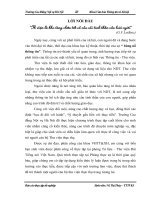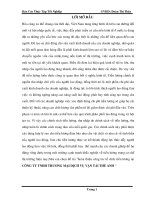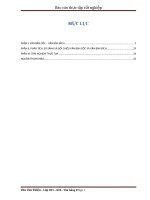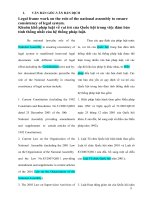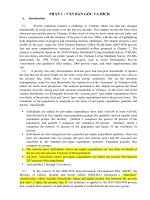Báo cáo thực tập tốt nghiệp tiếng anh (55)
Bạn đang xem bản rút gọn của tài liệu. Xem và tải ngay bản đầy đủ của tài liệu tại đây (182.22 KB, 23 trang )
TABLE OF CONTENTs
page
TABLE OF CONTENTS................................................................................i
ABBREVIATIONS.......................................................................................iii
PART A: INTRODUCTION.........................................................................1
1. Reasons for choosing the topic..................................................................1
2. Aims of the study.......................................................................................1
3. Scope of the study.....................................................................................2
4. Methods of the study.................................................................................2
5. Design of the study....................................................................................2
PART B: DEVERLOPMENT.......................................................................3
CHAPTER I: THEORETICAL BACKGROUND........................................3
1.1. Speech acts.........................................................................................3
1.1.1. Structure of speech act................................................................3
1.1.2. Classification of speech acts.......................................................3
1.2. Politeness............................................................................................4
1.3. Face wants..........................................................................................4
1.3.1. Definition of face........................................................................4
1.3.2. Positive and negative face...........................................................5
1.4. Politeness strategies............................................................................5
1.5. Pre-sequence.......................................................................................6
1.5.1. Functions of pre-sequences........................................................6
1.5.2. Somes types of pre-sequences.....................................................6
1.6. A brief overview of Contrastive Analysis..........................................7
CHAPTER II: PRE-SEQUENCE IN INVITATION OR PRE-INVITATION
IN ENGLISH AND VIETNAMESE.............................................................8
2.1. Pre-invitation......................................................................................8
2.1.1. Definition of pre-invitation.........................................................8
2.1.2. Positions of pre-invitation...........................................................9
2.1.2.1. Before invitation...................................................................9
2.1.2.2. After invitation.....................................................................9
2.2. Pre-invitation in politeness strategy...................................................9
2.3. Pre-invitation in language communication......................................10
2.3.1. Purposes of using pre-sequence in invitation............................10
2.3.2. Forms of pre-invitation..............................................................11
2.3.2.1. Interrogative forms.............................................................11
2.3.2.1.1. Yes /No questions........................................................12
2.3.2.1.2. Informative questions..................................................12
2.3.2.1.3. Declarative questions..................................................12
2.3.2.1.4. Tag questions...............................................................12
2.3.2.2. Declarative forms...............................................................12
i
2.3.2.3. Exclamative forms..............................................................12
2.3.2.4. Conditional forms...............................................................12
CHAPTER III : SOME SIMILARITIES AND DIFFERENCES OF PREINVITATION BETWEEN VIETNAMESE AND ENGLISH....................14
3.1. Similarities.......................................................................................14
3.2. Differences.......................................................................................14
3.3. Some main reasons for differences..................................................15
3.4. Application in language teaching and learning................................15
PART C: CONCLUSION...........................................................................17
1. Recapitulation..........................................................................................17
2. Suggestion for further studies.................................................................18
REFERENCES...............................................................................................19
ii
ABBREVIATIONS
CA : contrastive analysis
Fig. : figure
e.g : for example
FTA: face threatening act
H’s: his or her
i.e. : that is to say
T : turn
iii
PART A: INTRODUCTION
1. Reasons for choosing the topic
In communication, participants always try to achieve something in their
turns. To achieve the goals of communication, speakers usually try to plan
their actions logically and use the communicating strategies through speech
acts. In conversation, we must use some certain kinds of speech acts which
are likely to threaten another’s face. To reduce the greatest risk, people often
use many strategies. One of these strategies is using pre-sequences. However,
in text books for pupils, pre-sequences are not often presented. For example, a
conversation is used to teach about how to make an invitation, often just
present the inviting act only.
A : Let’s go to the movie tonight.
B : I have to study for an exam.
Terasaki (1976) has pointed out, in ordinary conversation invitations
are not made in simple pairs such as invitation and denial or invitation and
acceptance. More routinely, the inviter issues a pre-invitation in order to find
out what likely result of any subsequent invitation will be.
A : What are you doing tonight? (pre-invitation)
B : Not much. (positive response to project invitation)
A : How about a movie? (invitation)
The reason of writer for doing this study is to give knowledge to the
readers about the pre-sequences, especially, pre-invitation. From this study,
the writer hopes that it can give description of what is meant by pre-invitation
especially in helping people for better arranging and understanding
conversations.
2. Aims of the study
This study helps the readers understanding about the meaning of preinvitation and its usage in conversation. The writer wants to describe the
forms and functions of pre-invitation in order to help the readers to organize a
better conversation, especially, when they want to make an invitation, to
achieve the best result as well as to avoid putting participants in difficult
position.
3. Scope of the study
This study focuses on the utterances which contain pre-sequences,
especially, pre-invitation. The writer presents some main purposes of using
pre-invitation and its common forms with the examples in both English and
Vietnamese.
4. Methods of the study
To conduct the study, we have used the following methods:
Analysis
Statistics
Comparative and contrastive methods
5. Design of the study
The thesis comprises three main parts:
Part A : Introduction
This part presents the reasons for choosing the topic, aims, scope,
methods and format of the study.
Part B : Development
This is the main part of this study devided into three chapters:
Chapter I:
Theoretical background.
Chapter II:
Pre-invitation in English and Vietnamese
Chapter III:
Some similarities and differences
Part C: Conclusion
This part reviews major findings of the thesis and suggests some directions
for further study.
PART B: DEVERLOPMENT
CHAPTER I: THEORETICAL BACKGROUND
1.1.
Speech acts
According to Yule (1996: 47) “actions performed via utterances are
generally called speech acts”. The philosopher J.L. Austin considered speech
acts as “utterances (things people say) are equivalent to actions”. We perform
speech acts when we offer an apology, greeting, request, complaint, invitation,
compliment, or refusal. A speech act is an utterance that serves a function in
communication.
1.1.1. Structure of speech act
According to Austin, there are three types of acts that can be performed
by every utterance, given the right circumstances:
Locutionary
Illocutionary
Perlocutionary acts
1.1.2. Classification of speech acts
In 1975, Searle suggested the following classification of speech acts:
Assertives (Representatives)
They commit the speaker to something being the case.
No one makes a better cake than me.
It was a nice day.
Directives
They try to make the addressee perform an action. In other wosds,
speaker use these kinds of speech acts to get somone to do something.
Could you close the window?
Would you like to have a cup of coffee?
Commisives
They commit the speaker to doing something in the future.
I'm going to Paris tomorrow.
I’ll be back.
Expressives
They express how the speaker feels about the situation.
I am sorry that I lied to you.
Congratulation!
Declarations
They change the state of the world in an immediate way. The speaker
has to have a special institutional role, in a specific context, in order to
perform a declaration appropriately.
Boss : You are fired!
Priest: I now pronounce you are husband and wife.
Referee : you’re out !
1.2. Politeness
According to Yule (1996 : 60) politeness is treated “as a fixed concept,
as in the idea of polite social behavior, or etiquette, within a cuture. It is also
possible to specify a number of different general priciples for being polite in
social interaction within a particular culture. Some of these might include
being tactful, generous, modest, sympathetic toward others”.
Yule defined politeness “as the means employed to show awareness of
another person’s face”. Another linguistic, Leech defined politeness as forms
of behaviour that establish and maintain comity. That is the ability of
participants in a social interaction to engage in interaction in an atmosphere of
relative harmony.
1.3. Face wants
1.3.1. Definition of face
Face, as a technical term, means the public self-image of a person. This
is emotional and social sense of self that every person has and expects
everyone else to recognize.
Face threatening act
If someone say something that represents a threat to another person’s self
image that is called a face threatening act.
Face saving act
Whenever you say something that lessens the posible threat to another face, it
is called a face saving act
1.3.2. Positive and negative face
The concept “face” consists of two related aspects: negative face and
positive face.
Negative face
Brown and Levinson (1987) stated that negative face is “the basic claim
to territories, personal pre-sereves, rights to non-distraction, i.e., to freedom of
action and freedom from imposition”
Positive face
Positive face is “the need to be accepted, event liked, by other, to be
treated as a member of the same group, and to know that his or her wants are
shared by other” (quoted in Yule, 1996).
1.4. Politeness strategies
The chart below shows that the speaker has a set of strategies
available to redress FTAs, which are mutually known to both speaker and
addressee.
Circumstances determining choice of strategy
Lesser
1. without redressive action baldly
on record
Do the FTA
2. positive politeness
with redressive action
4. off record
3. negative politeness
5. Don’t do the FTA
Greater
Figure1:Possible Strategies for realising FTAs
(Brown and Levinson 1987:60)
There are four types of politeness strategies, described by Brown and
Levinson, that sum up human "politeness" behavior: Bald On Record,
Negative Politeness, Positive Politeness, and Off-Record-indirect strategy
1.5. Pre-sequence
A sequence is a unit of conversation that consists of two or more
adjacent and functionally related turns. In other words, sequences are turns of
talk from the beginning to the end of action (Schegloff, 1995).
Pre-sequence is a sequence which includes a turn recognizable as
potential initiation of another specific type of turn. Pre-sequence means
certain utterances came before the other utterances which is in the beginning
of a conversation or certain utterances belong to the opening sequence of a
conversation. Pre-sequence occupy a position of the speaker and the hearer in
order to differentiate between the formal and informal conversation. It means
that the speaker and the hearer can arrange their conversation by themselves
into formal and informal through the pre-sequence utterances by them.
1.5.1. Functions of pre-sequences
Actually, the function of pre-sequence is showing how speakers have
taken on the ideas that the talk is sequential, one thing after another, and how
they are careful in the order in which they present possiblities.
Besides, pre-sequences became delivering tool of a message to give
information about the main point conversation in order to be more specific.
Then, pre-sequence also has the important role in arranging and managing the
conversation. Moreover, pre-sequences can be used for inquiring about status
of the speaker or the hearer, status of situation and others.
Other fuction of pre-sequence is that it is used by participants in
conversation to draw hearer’s attention to or prepare the ground for the kind
of turn that are going to take next.
1.5.2. Somes types of pre-sequences
Pre-invitation (e.g. Are you free tonight?)
Pre-announcement (e.g. You won’t believe this.)
Pre-arrangement (e.g. Would you like to make an appointment later on?)
Pre-request (e.g. Do you have coffee to go?)
Pre-closing (e.g. Okay.)
1.6. A brief overview of Contrastive Analysis
Contrastive analysis (CA) is the systematic study of a pair or more of
languages with a view to identifying their structural differences and
similarities.
Contrastive Analysis is not only very important for teaching and
learning second language but it can also make useful contributions to machine
translating and linguistics typology. Contrastive Analysis is the useful method
for linguistic study.
CHAPTER II: PRE-SEQUENCE IN INVITATION OR PREINVITATION IN ENGLISH AND VIETNAMESE
2.1. Pre-invitation
As introduced above, one type-specific pre-sequences is the preinvitation. This often placed near the opening of a conversation but could be
placed sequentially before the closing. “Are you doing anything? What are
you doing this weekend?” are typical pre-invitation (Scheloff, 1995). Terasaki
(1976) has point out, in ordinary conversation invitations are not made in
simple pairs such as invitation and denial or invitation and acceptance.
A : Let’s go to the movie tonight.
B : I have to study for an exam.
More routinely, the inviter give a pre-invitation in order to find out
what likely result of any subsequent invitation will be.
A : What are you doing tonight? (pre-invitation)
B : Not much.
(positive response to project invitation)
A : How about a movie? (invitation)
B : Okay.
(acceptance)
2.1.1. Definition of pre-invitation
A pre-invitation is a pre-sequence that is likely to be understood by the
respondent as a signal of a coming invitation. The coming invitation may be a
question-answer sequence concerning the availability of the participant to be
invited (cited by Levinson, 1983). In others word, pre-invitation is a way to
get ideas about how participant will respond to an invitation.
A: Hi, John.
B: Say, what’re you doing?
A: Well we’re going out. Why?
B: Oh, I was just gonna say come over here this evening.
In Viet Nam, Nguyen Thien Giap (2000) defined pre-invitation as the
words used to visualize the ability of the action. And below is his example of
pre-invitation :
A : Tối nay anh có làm gì không?
B : Khơng. Thế thì sao?
A : Đến tơi chơi cờ đi.
There are many ways to make an invitation but how to avoid the risk of
this action. Using pre-invitation is a safety solution to avoid the risk and
makes both speaker and hearer more comfortable in conversation.
2.1.2. Positions of pre-invitation
2.1.2.1. Before invitation
Pre-invitation often precedes invitation in everyday conversation.
Therefore, we often see it before invitation than after invitation.
(1) Pre-sequence and invitation are in the same turn.
Em đi có một mình à? Ta vào kia uống cà phê đi.
(2)pre-sequence and invitation are in the separate turns:
A : What are you doing tonight? (pre-invitation)
B : Not much.
(go- ahead)
A : How about a movie?
(invitation)
B : Okay.
(response)
(2’) there are more than one pre-sequence
A : What are you doing tonight. (pre-invitation 1)
B : I have to study for an exam. (negative response)
A : How about Wednesday?
(pre-invitation 2)
2.1.2.2. After invitation
When pre-invitation appears after invitation, it often has one certain
function, that is persuade or encourage the hearer to accept the invitation. This
phenomenon is often seen in Vietnamese and is a special position of presequence. In this case, pre-invitation is often given right after the invitation.
-Em chỉ thèm một ly cà phê.
- Vậy thì ra qn. Ở ngồi cổng có một quán khá lắm.
- Để em vào xin mẹ đã.
(Nguyễn Hải, 1992)
- Dine with me and Fritz at the inn in the park. We will have roast
pheasants and porter, plum-pudding and French wine.
2.2. Pre-invitation in politeness strategy
During conversation, participants always try to achieve something in
their turns. To achieve the goals of communication, speakers usually try to
plan their actions logically, the participants should predict the others’
attentions through their utterances than understand the meaning of the words
only. Similarly, when speakers wants to invite someone to do something, they
must consider carefully before making an invitation in order to achieve their
goals.
The basic assumption from the perspective of politeness, is that face is
typically at risk when the self need to accomplish something involving other.
The greatest risk appears to be when the other is put in a difficult position.
One way of avoiding risk is to provide an opportunity for the other to halt the
potential risky act. For example, rather than simply make an invitation,
speaker will often first produce what can be describe as pre-invitation. The
advantage of the pre-invitation element is that it can be answered either with a
“go-ahead” response, or with a “stop” response. In invitation, the use of presequence is considered a politeness strategy.
A go-ahead response encourages the speaker to produce invitation.
A : Watcha doin’? (pre-invitation)
B : Not much.
(go-ahead response)
In contrast to a go-ahead response, a blocking response can discourage
the production of the relevant first pair part (invitation).
Tơi có hai vé xem phim tối nay.
Ngày mai tôi thi.
Apart from go-ahead response and blocking response, there is a common type
of response to pre-invitation – hedging response.
Pedro : Are you busy Saturday night, Jill?
Jill : Well …uh…I don’t have any definite plans yet. Why?
2.3. Pre-invitation in language communication
2.3.1. Purposes of using pre-sequence in invitation
As discussed above, pre-sequences have many different functions. So
they are used in different ways, depending on the speaker’s purposes. This
research will present some common purposes of speakers when they use preinvitation.
to get the idea about how participant will respond to invitation before
they make an invitation
A : Are you doing anything on Saturday everning?
B : I don’t think I am.
to avoid putting both the hearer and the speaker in a difficult position
A : Tơi có hai vé xem phim tối nay.(pre-invitation)
B : Ngày mai tôi thi.
to get the hearer’s attention
A : Tối nay bạn có rỗi khơng?
B : Khơng, mà có chuyện gì cơ?
to be a reason for invitation
A : I’m having friends to dinner on Sunday, and I ‘d really you to come.
B : Sure !
to persuade the invitee to accept the invitation
A : Say, we’ve come here to dance but not to sit and listen. Why not
have a dance?
B : You are right, dear. Sitting is boring, but I’m not good at Tango.”
2.3.2. Forms of pre-invitation
The author has collected many examples of pre-invitation in many
books, stories, documents. After arranging the examples, we can recognize
some main forms of pre-invitation in English and Vietnamese including
interrogatives, declaratives, exclamatives.
2.3.2.1. Interrogative forms
This is the most common form of pre-invitation is used. It can express
many different purposes of speaker and the invitee also recognizes the aim of
speaker more easily. It can be said that interrogatives are the typical form of
pre-sequences. The author divided the interrogative form into many sub-types
such as Yes/No questions, Informative questions, Declarative questions, Tag
questions.
2.3.2.1.1. Yes /No questions
A: Anh có lạnh khơng?
B: Khơng anh ạ.
A: Vậy ra sân uống cà phê nhé!
B: Xin vâng.
(Khải Hưng)
2.3.2.1.2. Informative questions
Tonny : Say, Anna, what are you doing tonight? Would you like to go
out?
Anna : Oh, sorry, I can’t. I’m going to work late tonight. I have to
finished this report.
Tonny : Well, how about tomorrow night? Are you doing anything
then?
2.3.2.1.3. Declarative questions
You are free now. Let’s go to have some coffee.
2.3.2.1.4. Tag questions
- Em đi có một mình à?
- Ta vào kia uống cà phê đi.
(Trần Chiến, 2000)
2.3.2.2. Declarative forms
A : I’m going to park with some friend for a barbecue on Sunday.
Would you like to join us?
A: Tơi có hai vé xem phim tối nay.
B: Ngày mai tơi thi.
A: Tiếc nhỉ.
2.3.2.3. Exclamative forms
- Em mới tìm ra một hàng ăn ngon lắm! Ta đi ăn nhé!
- Để khi khác, muộn mất rồi. Bây giờ anh muốn nghe em nói chuyện
(Nguyễn Thị Ngọc Tú, 1979)
2.3.2.4. Conditional forms
- Nếu Un thích đi đị trên sơng thì anh tình nguyện chở Uyên đi được
không?
- Em thích chứ!”
(Minh Uyên, 1998)
However, in daily conversation speaker can use many forms at the
same time to increase their effects.
- Nếu Loan đồng ý (conditional form), Anh mời Loan đi ăn kem. Ở chỗ
kia có kem Bắc cực ngon lắm!. (exclamative form)
In conclusion, there are many forms of sentences used to make preinvitation. Each type has different functions and different ways to express
speaker’s purpose.
CHAPTER III : SOME SIMILARITIES AND DIFFERENCES
OF PRE-INVITATION BETWEEN VIETNAMESE AND
ENGLISH
3.1. Similarities
In daily conversation, pre-invitation is used commonly in both English
and Vietnamese with the same purposes:
The most used form of pre-invitation in both English and Vietnamese is
interrogative form, declarative form is used less than interrogative form. In
the interrogative form, the most sub-form used is Yes/No question.
3.2. Differences
Pre-invitation in Vietnamese is more flexible, it is used in many
different forms, in many different positions while in English we just see preinvitation with interrogatives and declaratives. Vietnamese people use more
forms than English people do, apart from the common forms such as
interrogative, declarative, exclamative, in Vietnamese, we can also see preinvitation in imperative form.
English people use more interrogative forms, and less exclamative
forms than Vietnamese people do.
Pre-invitation seldom appears after invitation in English. In contrast,
pre-invitation appears after invitation more frequently in Vietnamese,
especially, there are some typical phrases which often follow invitation in
order to persuade the hearer and make the invitee feel more comfortable such
as “Đừng làm khách”, “cứ tự nhiên”, “xin cứ coi như người nhà”, “chúng
tôi coi anh/chị như người nhà”….
About the answers for pre-invitation question, Vietnamese often use
hedging response. We can see very clearly through the collected examples.
However, English people often answer directly by “stop” response or “goahead” response. This shows Vietnamese people’s habit of indirect talking,
often avoid talking directly, try to keep a good relationship with others. This is
a special characteristic of Vietnamese communication style which will be
introduced in the next article.
A habit of Vietnamese people is asking some questions around the main
topic before going to the target. This is seen clearly in Vietnamese
communication style, it also called “go around talking”. Similarly, before
making an invitation, Vietnamese people often talk about something related to
the invitation, one of them is considered pre-invitation.
Other differences of pre-invitation in Vietnamese and English is that in
Vietnamese, pre-invitation can express the speaker’s feeling and attitude more
clearly. By go with the exclamative words and the final particles, preinvitation can show that the relatioship between speaker and hearer is close or
distant, speaker is older or younger than hearer or the social status of speaker
is higher or lower than hearer.
Vietnamese is more flexive and has more variants than English. Preinvitation in Vietnamese can be a phrase, a clause or sentences, depending on
the specific situation and speaker’s purposes. And pre-invitation in Enlgish
often a clause or a sentence. There is hardly seen a phrase as a pre-invitation.
3.3. Some main reasons for differences
There are several reasons which cause the differences between English
and Vietnamese in invitation such as the diferent in culture, society, and many
things of life. All these things are showed in communication styles, let’s see
how different between the two countries’ communication styles.
Some common charateristics of both English and Vietnamese
communication style are pointed out. Through these characteristics of each
language, we can see the differences between the two languages, the two
countries’culture. That is the reason why they creat the differences of preinvitation. We will deal with some common charateristics of English and
Vietnamese communication styles which can help communicators of English
achieve greater success and avoid awkwardness in communication.
3.4. Application in language teaching and learning
As there is no indication from research that all invitations in natural
conversation are preceded by pre-invitations, it is not necessary for every
invitation to be preceded by a pre-invitation. However, if students are to learn
about interaction, pre-sequences are an important part of the picture. Because
the pre-sequences such as pre-invitation, pre-request, pre-announcement
project future actions, language learners need to able to recognize these types
of pre-sequences in order to able to respond appropriatly. These types of presequences are also solutions language learners can use to avoid receiving
dispreferred responses.
By combining with other subjects teacher can teach students about preinvitation effectively. For example, teacher can let students listen some
conversation about invitation, after that ask them to identify pre-invitation,
which form it is, and speaker’s purpose when using it. This activity not only
can help students improve listening skill but also help student understand
more clearly about pre-invitation’s role in daily conversation.
PART C: CONCLUSION
1. Recapitulation
Invitation is a tactful act in Vietnamese culture and in English,
invitation is considered a polite request. Moreover, in both English and
Vietnamese, invitation is a speech act that can threaten the participants’ faces,
and put hearer in difficult position. That is reason why before making an
invitation, speaker must plan the conversation carefully to achieve H’s goals.
One special part of an invitation that helps speaker to avoid putting hearer in
difficult position and makes both speaker and hearer feel more comfortable is
pre-invitation but in English teaching program it is rarely mentioned. This
reason had urged author to do study on pre-invitation in conversation.
This thesis has fist dealt with some theoretical backgrounds about
speech acts, face wants, politeness and politeness strategies, presequences and some overview of CA.
Next,
chapter
II
presents
pre-invitation,
its
positions
in
conversation, its common forms and speaker’s purposes of using it. After
collecting and arranging examples in forms, there are some common forms of
pre-invitation considered, including interrogatives, declaratives, exclamatives.
In which, the most used form is interrogatives and it is divided into many subforms such as yes/no question, informative questions…
Finaly, in chapter III some similarities and differences were pointed
out with specific examples. Then are some application in language
teaching and learning, especially about making and responding to preinvitation.
From this study, the writer hopes that it can give description about what
is meant by pre-invitation especially in helping people for better arranging
and understanding conversation, helps the readers understanding about the
meaning of pre-invitation and its usage in conversation. Especially, after
reading this study, readers will know the common forms and purposes of
using pre-invitation, and recognize it in conversation easily. Using pre-
sequences, especially, using pre-invitation, speaker not only can achieve the
communicating target but also can avoid putting the hearer in difficult
position. Therfore, using pre-invitation can be considered a conventional and
common communication strategy that we should apply in daily conversation.
2. Suggestion for further studies
There are several other types of pre-sequences such as prearrangement, pre-announcement, pre-request, pre-closing. we can study on
these types of pre-sequences and compare the similarities and differences
between them., we can provide more exercises and more specific situations
for learner to make the study more practical. The studies on language in
communication will be good references for language learner to understand
more clearly about interaction and to avoid confusing in daily
communication.
REFERENCES
English:
1. Austin, J. L. (1962). How to do things with words. Cambridge, MA:
Harvard University Press.
2. Brown, P., & Levinson, S. (1987). Politeness: Some universals in language
usage. Cambridge: Cambridge University Press.
3. Eelen, G. (2001). A Critique of Politeness Theories. Manchester: St.
Jerome Publishing.
4. Fisiak, J. (Ed.) 1981. Contrastive Linguistics and the Language Teacher.
Oxford: Oxford University Press.
5. Lakoff, G. (1972). Hedges: A Study in Meaning Criteria and the Logic of
Fuzzy Con-cepts, in Paul Peranteau, Judith Levi and Gloria Phares
(eds.), Papers from theEighth Regional Meeting, Chicago
Linguistics Society (CLS 8), pp 183-228.
6. Leech, G.(1983).Principles of pragmatics. London: Longman
7. Levinson, S. C. (1983).Pragmatics. Cambridge, England: Cambridge
University
8. Locher, M. (2004). Power and politeness in action. Berlin: Moulton Press
9. Richards, J. C., Hull, J. and Protor S.(2004), New Interchange,
Cambridge University Press.
10. Richards, J. C. (1997). Developing Tactics for Listening, Nxb Tp Hồ Chí
Minh.
11. Searle, J. R. (1975).A taxonomy of illocutionary acts. Language, Mind
and Knowledge, Minnesota Studies in the Philosophy of Science,
pages 344-369
12. Searle,J.R.(1969). Speech act, an essay in the philosophy of language,
Cambridge- England-CUP-1971.
13. Terasaki, A.(1976). Pre-announcement sequences in conversation. Social
Science Working Paper 99. Irvine, CA: University of California,
Irvine, School of Social Science.
14. Thackeray, W. M. (1948). Vanity Fair, The Zodiac Press, London.
15. Yule, G.(1996). Pragmatics. Oxford University Press.
Vietnamese:
1. Trần Thi Bảo Châu, Có em bên đời: Chương 1,
/>2. Hồng Chiến (2000). ‘Nỗi sợ’, Truyện ngắn hay Việt Nam, (Tập 4), Nxb
Hội Nhà văn.
3. Nguyễn Thiện Giáp (2000). Dụng học việt ngữ. NXB Đại học quốc gia Hà
Nội.
4. Nguyễn Hải (1992), Có em trên đời, Nxb Trẻ.
5. Hồng Hoang (2000). ‘Chữ kí’, Truyện ngắn hay Việt Nam, (Tập 4), Nxb
Hội Nhà văn.
6. Khái Hưng (1999). Nửa chừng xuân, Nxb Văn nghệ Tp.HCM.
7. Nguyễn Văn Lập (1989). Bước đầu tìm hiểu nghi thức lời nói tiếng Việt,
luận văn sau đại học khóa 12, Chun ngành ngơn ngữ, Trường ĐHSP
I Hà Nội.
8. Nguyễn Văn Lập, Hành vi lời mời trong sự tương tác mời đáp. Tập san
trường Đại học KHXH-NV, Đại học quốc gia TP Hồ Chí Minh.
9. Vũ Hồng Mai (1997). Con trai không như con gái tưởng, Nxb Đồng Nai.
10. Lê Ngọc Minh (1997). “Bố vợ”, Tuyển chọn truyện ngắn hay, Nxb Hội
Nhà văn.
11. Khương, Lưu Qúy, An Investigation into Spoken Direct Invitations in
English and Vietnamese.Trường Đại học Ngoại ngữ, Đại học Đà
Nẵng.
12. Nguyễn Quang (1999). Intercultural communication. NXB Đại học quốc
gia Hà Nội.
13. Nguyễn Thị Ngọc Tú (1979). Những dấu chấm phía chân trời, NXB Kim
Đồng.
14. Minh Uyên (1998). Có một mùa hè, Nxb Đà Nẵng.
Website:
1. />2. />3. />



